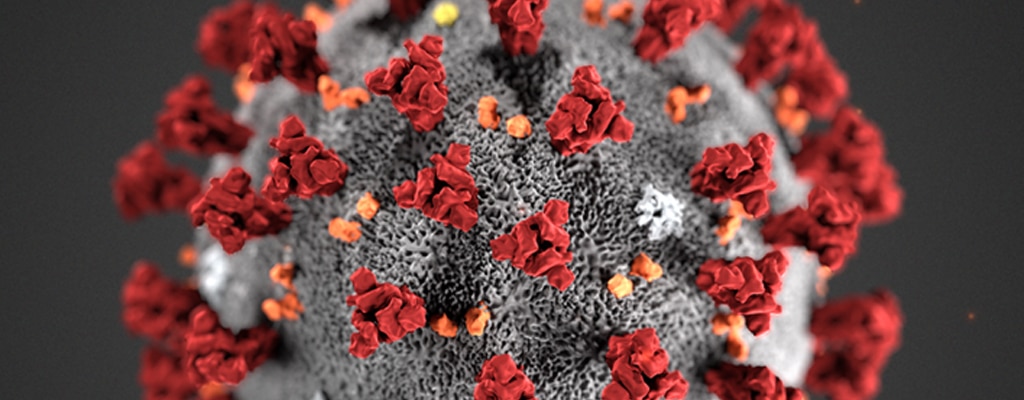What is a virus?
A virus is a very tiny particle of RNA or DNA genetic code protected by an outer protein wrapper.
How common are viruses?
Viruses are everywhere. It’s amazing to realize that if you add them all up, all the viruses in the world weigh more than all the living matter in the world – including all of the plants, animals and bacteria. 10% of the human genome is derived from virus DNA. The Earth truly is a “virus planet!”
Why is it so hard to stop a virus from spreading?
Because virus particles are so incredibly small, billions can float on tiny droplets in the air from just one cough. 100 million viral particles of the novel coronavirus can fit on a pinhead. That’s how incredibly small they are.
What do virus particles do?
Virus particles try to insert themselves into living cells in order to multiply, infect other cells and other hosts. Viruses act like parasites. They hijack living cells in order to force each cell to make more viruses. When a cell is hijacked, the virus sends out hundreds or thousands of copies of itself. It often kills the hijacked cell as a result.
What is the difference between SARS-CoV2 and COVID-19?
SARS-CoV2 is the virus; COVID-19 is the disease which that virus spreads. In the press it is normally called CORONA or COVID-19
What does it look like?
SARS-CoV2 looks like a tiny strand of spaghetti, wound up in a ball and packed inside a shell made of protein. The shell has spikes that stick out and make it look like the corona from the sun. This family of viruses all has a similar appearance; they all look like a corona.
How many kinds of viruses exist, and how many of them are harmful to humans?
Of the millions of types of viruses, only a few hundred are known to harm humans. New viruses emerge all the time. Most are harmless.
On average, how many particles of the virus does it take to infect you?
We really don’t know yet for SARS-CoV2. It usually takes very little.
How many different coronaviruses affect humans?
There are 7 coronaviruses that have human- to-human transmission. 4 generate a mild cold. But 3 of them can be deadly, including the viruses that cause SARS and MERS, and now the new coronavirus, SARS-CoV2.
Why is it called the “novel” coronavirus?
Novel just means it is new to humans, meaning that this specific virus is one that we’ve never seen before. Our immune system has been evolving for 2 million years. But since our bodies have never seen this virus before, there has been no opportunity for humans to develop immunity. That lack of immunity, combined with the virus’s ability to spread easily and its relative lethality, is why the arrival of SARS-CoV2 is so disturbing.
How easily does the new virus spread?
SARS-CoV2 spreads fairly easily from person to person, through coughs and touch. It is a “respiratory transmitted” virus.
How is this new virus different from the earlier known coronaviruses that spread SARS or MERS?
SARS-CoV2 is different in 4 critical ways: First, many infected people have no symptoms for days, so they can unknowingly infect others, and we don’t know who to isolate. This is very worrisome because SARS-CoV2 is highly infectious.
Second, 80% of the time, COVID-19 is a mild disease that feels like a minor cold or cough, so we don’t isolate ourselves, and infect others.
Third, the symptoms are easily confused with the flu, so many people think they have the flu and don’t consider other possibilities.
Fourth, and perhaps most importantly, the virus is very easy to spread from human to human because in the early stages it is concentrated in the upper throat. The throat is full of viral particles so when we cough or sneeze, billions of these particles can be expelled and transmitted to another person. The disease often starts in the throat (which is why tests often take a swab from the throat) and then as it progresses it moves down to the lungs and becomes a lower respiratory infection.
Can a person be infected with the new virus and never show symptoms at all?
Unfortunately, yes. Many infected people do not show any symptoms for the first few days and then a mild cough or low fever shows up. This is the opposite of SARS, where you had clear symptoms for a few days but were only contagious when sick.
If you have no symptoms, can you still infect other people?
Unfortunately, yes. And that makes it much more difficult to slow the spread.
How likely is it that scientists will develop a vaccine to prevent people from getting infected?
It is reasonably likely, but there are no guarantees that we will even have a vaccine. Failure is possible. I’m optimistic that we will develop a vaccine for SARS-CoV2, but we will have to extensively test it for efficacy and safety – which takes a lot of people and time.
We will have vaccine “candidates” in a month or two. But because of the need for extensive testing to prove it protects and is safe, it will be at least a year before we have a vaccine we can inject into people that is approved by a major regulatory agency. In fact, 18 to 24 months is more likely by the time we scale it up to millions of doses.
Can’t we develop a vaccine faster?
Unfortunately, there are no shortcuts. The human body’s immune system is complex and unpredictable. Viral mutations may occur. Children are different from adults. Women may respond differently than men. We need to be sure that any vaccine is 100% safe for everyone who gets it. To accomplish that, we need to test drugs and vaccines at various doses on a wide range of healthy human volunteers under carefully measured conditions.
Have we made progress already?
The good news is that only weeks after the discovery and isolation of SARS-CoV2, which occurred in early January of 2020, vaccine development started immediately. Funding has been allocated by many governments and many companies and scientists around the world are working on it with great urgency.
Are Arctic Aurora LifeScience invested in companies developing vaccines and other treatments fighting SARS-CoV2?
Yes indeed. We are invested in Gilead that is testing a compound designed to slow down the virus replication inside your body. First results planned in April 2020. Other companies active in the field and in our portfolio is J&J, Alnylam
How deadly is the new virus?
Most scientists believe that it kills 1% to 2% of all the people who become infected. The WHO currently reports a higher figure of more than 3%, but that estimate is likely to come down as they figure out how to count many unreported or mild cases. Mortality is clearly higher in older people and those with underlying medical conditions.
So what are the numbers and checkpoints to focus on?
80-90% of the time it’s a mild disease, but in 10-20% of cases it becomes more severe, with the worst cases reporting high fever or shortness of breath. As a result some people require hospitalization, and some will need intensive care to survive through a few critical days when their lungs are extensively infected.
Which groups of people are most at danger here
The older you are, the higher your risk. Also at greater risk are people with underlying diseases such as diabetes, chronic obstructive lung disease and pulmonary disease or cardiovascular disease or immune deficiencies.
How much danger do these high-risk groups face?
Their mortality rate can be as high as 10% or even 15%. And, the risk increases when you have more health conditions.
It seems that generally speaking, children and young people are only mildly affected, if at all. Is that true?
This is what it looks like, but as with so many other issues on COVID-19, this requires confirmation.
Does the new virus spread as easily as the flu?
The new virus appears to spread as easily as the flu.
Is the flu also caused by a virus?
Yes. Flu is caused by the influenza virus. But the influenza virus and coronavirus are very different. A flu shot doesn’t help you with the new coronavirus, but it greatly reduces your risk of flu. The common cold, for which there is no vaccine or cure, is often caused by another type of tiny virus called a rhinovirus, and occasionally another coronavirus.
How does the infection progress when the new coronavirus gets a foothold in your body?
It usually starts with a cough. Then a low fever. Then the low fever turns into a high fever and you get shortness of breath.
At what point is good medical care the difference between life and death?
It is usually when your fever is very high and your lungs are compromised so that you are short of breath or you need help to breathe.
How does the new virus get to new places around the world?
By road, air and sea. Viruses travel by airplane nowadays. Some of the passengers may carry SARS-CoV2.
Why might a country close its schools?
Countries such as Norway, Denmark, Japan, Italy, France and to a certain degree USA are closing schools. It’s because scientists don’t know how much of the spread is accelerated by children who are carriers. Countries are trying very hard to slow the spread. Children generally pass along viruses quickly since they don’t wash their hands or practice much personal hygiene.
They play a big role in how the flu spreads which is why many countries have been closing schools in affected areas. In contrast, Sweden has not yet recommended to a general closure of schools and universities.
If I get infected, are there drugs I can take to make the virus less severe, or make it go away entirely?
No drugs have yet been proven effective as a treatment or what doctors call a “therapy.” A lot of different drugs are being tested in clinical trials, so hopefully that will change for the better soon.
What about all kinds of new cures and therapies and treatments I’ve heard about on the Internet?
There are going to be endless false claims. Only when you read about it on multiple reliable websites, can you feel confident there is real science. But most of what you hear will be total rubbish, so be very careful, and don’t spread unconfirmed rumors.
What are the advantages of masks when used properly and who should wear masks?
The best masks, carefully fitted and worn properly, slow down the spread FROM sick people coughing. Meaning, the mask is not to protect you from other people; it is to protect other people from you. It is a courtesy to others to wear a mask when you get what you think is a cold, and you start coughing. Masks have an additional benefit: they make it less likely that you will touch your mouth, so it becomes less likely that if you have the virus on your hands, you will transfer it into your body. Masks provide benefits for healthcare workers. If you work in a healthcare setting or in elder care, masks are mandatory.
Is there anything I can do to prevent from becoming infected?
Washing hands frequently, not touching your face, coughing and sneezing in your elbow or a paper handkerchief, not shaking hands or hugging all reduce your risk. If you are sick, stay home and consult with a doctor over the phone to see what to do next.
What does “mitigation” mean?
Mitigation means slowing the spread of the virus, and attempting to limit its effects on public health services, public life and the economy. Until there’s a vaccine, what we can do is slow it down. That is really important.
What other ways can we slow down the spread of the virus?
Good hygiene and common courtesy can slow down the spread. In addition, “social distancing” measures — such as working from home, not taking a plane, closing schools, and banning major gatherings — will help slow the spread of SARS-CoV2.
What will it take to stop this virus?
Nobody really knows for sure, but China has shown that it is possible to stop the spread significantly. A vaccine may be necessary to fully eliminate SARS-CoV2.
How long will it take for the new virus to spread through a population?
Left to spread with normal measures of good hygiene, SARS-CoV2 appears to double its infected population about every week. That means it will go from 50 people who are infected to 1 million people infected in about 14 weeks. That’s the simple arithmetic of contagion. Of course, we can do things to slow it down.
How effective is good hygiene in slowing down the spread of coronavirus? Do the numbers of infected people decrease noticeably if people follow the guidelines?
The numbers change based on how careful people are, and even small changes are important to avoid stressing the healthcare system more than absolutely necessary.
What is the main symptom that people should be on the lookout for?
Coughing is the #1 symptom.
Is fever a good way to identify infected people?
A high fever may be cause for concern and is worth getting medical attention. But screening for fever alone, at an airport or checkpoint for example, lets a lot of infected people pass.
What percentage of the people who tested positive in Chinese hospitals arrived without a fever?
About 30% of Chinese coronavirus patients had no fever when they arrived at the hospital.
If we get a “lucky” break or two in the coming months, what does being “lucky” look like?
Warm weather may slow down the spread, although we don’t have any evidence yet that this is the case. Singapore, which has 120 cases already, and has one of the best COVID-19 control programs in the world, is just 70 miles from the equator — so at least in that case, a warm climate has not stopped the virus from spreading.
It’s possible that SARS-CoV2 could steadily mutate into a less dangerous form so that fewer people die from it, as happened before with the swine flu in 2009. But I wouldn’t count on it. Quickly finding an effective drug therapy or cocktail of drugs would be excellent news. That’s about it for luck.
How do I know if I’m going to be in the mild group or the one that needs hospitalization?
You don’t know for sure, but being over 70 or having a chronic condition increases your risk of severe illness, and even death.
Should I be worried that I’m going to get COVID-19?
If you’re not at high risk, you shouldn’t worry too much, but you should do everything you can to avoid becoming infected as you don’t know individual outcomes. Everyone is eventually going to be at risk for acquiring this infection in the next few years, just as no one avoids the common cold or the flu over time.
Why is it so important to try to avoid getting it? If I get the virus immediately, then I can be done with it and move on.
We want to slow down the infection, which means slow down the number of new cases and total cases, so our hospitals can handle the most affected patients without getting overwhelmed or turning away patients with other types of illnesses that require immediate attention.
Is there any chance that this is one giant false alarm and that we’re going to look back this summer and say “wow, we all panicked over nothing!”?
No. COVID-19 is already in well over 100 countries and it’s highly contagious. Virtually every day there are more and more cases, in more countries. This is not a drill. It is the real thing.
What things to be encouraged about?
- Modern biology is moving at high speed
- In addition to the public health community worldwide, including the World Health Organization, Government leaders at the highest levels are focusing on the threat
- We isolated the virus in days and sequenced it quickly
- We are hopefully going to have a vaccine
- This is truly the age of modern communication. That can help us, as long as we debunk fake and dangerous news




Buy Viagra No Orsscriotion [url=https://apcialisle.com/#]Cialis[/url] Achat Cialis Aux Herbes Cialis Zithromax Alcohol